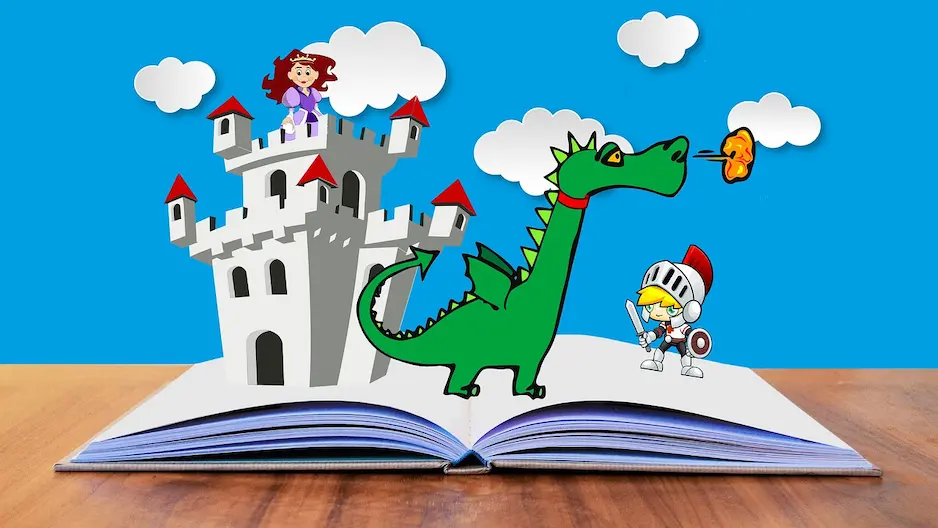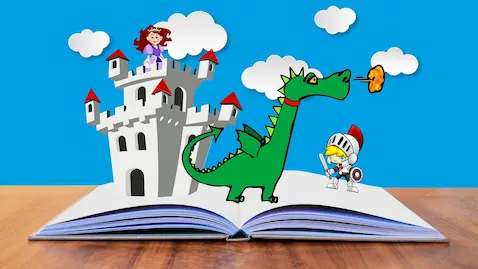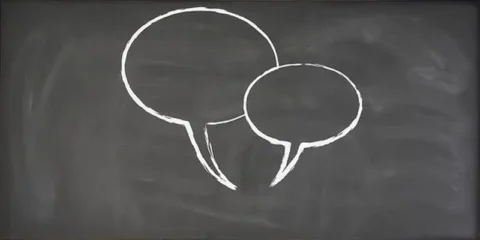Stories have always been at the heart of how people learn. In language teaching, storytelling does far more than fill the last ten minutes of a lesson – it builds shared attention, imagination, and natural communication. Interactive storytelling turns a traditional listening activity into a two-way exchange, where students shape the story as it unfolds. It’s simple to set up, and it works at almost any level.
What is interactive storytelling?
In interactive storytelling, you tell a story aloud in stages, pausing at key points to invite students to take part. They predict, imagine, describe, and decide what happens next. Each pause becomes a mini speaking task, while the story itself gives structure and meaning to their ideas. Because the students are personally invested in what happens, listening becomes active and speaking becomes purposeful.
How to set it up
Divide students into pairs or small groups. Tell them that you’re going to tell them a story, but that you’ll stop at certain points and ask for their ideas. Explain that they’ll help create details – what people look like, where things happen, what characters are thinking, or what might happen next. Reassure them there are no “wrong” answers, only ideas to feed the story forward.
When you pause, give students a short, focused question or prompt, for example:
- “What do you think this person looks like?”
- “Where do you think they are?”
- “What might they be thinking right now?”
- “What do you think happens next?”
Let them discuss in pairs for a minute, then invite suggestions from around the room. Choose one that fits your story (or improvise to connect it), and continue. If none fit, keep the flow natural: “Interesting guesses, but actually…” and carry on with your own version. This back-and-forth rhythm is what makes the story feel alive.
Choosing (or creating) your story
Almost any short story can work for interactive storytelling – a folk tale, a fable, a local legend, or even a personal amecdote or something you create yourself. Aesop-style fables work perfectly because they’re simple but rich in interpretation. The key is to pick one with clear characters, simple turning points, and moments where you can naturally pause and invite ideas.
- Length: Two to five minutes is ideal. If it’s longer, tell it in instalments over a few lessons.
- Language: Keep the grammar and vocabulary just above your learners’ level, so it stretches them without overwhelming them.
- Theme: Go for topics which work across cultures and ages – curiosity, cleverness, kindness, honesty, mistakes. Avoid stories which reinforce cultural stereotypes.
AI tools can help you quickly brainstorm story outlines. For example, prompt with “Write a 300-word story about a lost wallet with three clear pause points for prediction.” Adapt the prompt and the result for language, number of pauses and level of detail, according to your students’ level and your teaching context.
You can also encourage students to write or adapt their own stories for classmates to interact with. This works especially well for higher levels and adds genuine personalisation to your class. Ask them to base their story on a proverb, a local tale, or a real event from their lives, and to plan where the listener could pause and guess what happens next.
Below is one example you can use straight away, or as inspiration for creating stories of your own.
Note: This is a short version to illustrate the technique. You can easily expand it by adding more scenes, characters, or pauses to suit your class length, age and level.
A sample story: The Baker’s Secret
“There once was a baker who made the best bread in the village.”
Pause: What kind of person do you think he was? Describe his bakery. What might make his bread so special?
“Every morning, before sunrise, the smell of fresh bread filled the streets. People queued outside his shop, even in the rain. But when they asked for his recipe, the baker only smiled and said, ‘It’s a secret.’”
Pause: What do you think the secret ingredient could be?
“One day, a young apprentice begged him to reveal it. The baker finally agreed, but only if the boy promised not to tell anyone.”
Pause: What do you think the baker told him? Why might he be hesitant to share it?
“The next morning, the boy watched closely as the baker mixed, kneaded, waited, and baked, but there was nothing unusual. No spice, no honey, no special kind of flour.”
Pause: What do you think the boy says at this point?
“Finally, as they pulled the loaves from the oven, the baker smiled and said quietly, ‘That’s the secret. Every day, I whisper something kind about the people who will eat this bread.’”
Pause: What do you think the boy did with that secret? Would you have shared it?
The story ends there – simple and full of warmth. You can follow up naturally with a discussion about kindness, pride in work, or the value of small gestures.
Why interactive storytelling works
- Listening with purpose: Students listen actively because they know their ideas might shape what happens next.
- Speaking with creativity: The prompts push learners to use descriptive and speculative language, not just repeat phrases.
- Integrated skills: Students listen, speak, predict, and recall all within one coherent task.
- Natural motivation: Curiosity keeps them engaged. They genuinely want to know how it ends.
Tips for telling stories well
- Choose the right length: Two to five minutes is ideal. Long stories lose energy if you pause too often.
- Use gesture and voice: A little drama helps. Your tone, pace, and pauses make the story vivid.
- Plan your stopping points: Choose three to five natural moments where predictions or descriptions make sense.
- Add visuals: If you like, show some pictures to support the story or to mark characters and scenes.
- Follow up with language work or discussion: Use the story afterwards to review vocabulary or grammar, or discuss some of the themes.
Variations and extensions
- Student storytellers: Once they’ve seen you do it, let students try in pairs. One student tells a short story, the other interrupts with questions or suggestions.
- Chain story: Each student adds one line before passing the story on. Works well as a warmer or creative writing lead-in.
- Picture prompts: Give each pair a picture. They build a story together and present it to another pair for feedback.
- Retelling for accuracy: After the final story, ask students to retell it in their own words, focusing on sequencing and reported speech.
- Try it with video: You can run a version of this using short video clips instead of reading aloud. Mute the sound and tell the story as it plays, pausing for students to imagine what’s being said or what might happen next.
Adapting storytelling for preschool and young learners
With very young learners, storytelling becomes even more powerful, and much simpler. At this age, language learning happens through rhythm, repetition, and play rather than conscious grammar work. Keep stories short, visual, and full of movement. The goal isn’t to finish the plot but to enjoy the sounds, gestures, and imagination along the way.
- Keep it bite-sized: Two or three minutes of story time is plenty. You can return to the same story across several lessons, adding small new details each time.
- Use props and puppets: A soft toy or puppet can “tell” parts of the story, instantly drawing children in and reducing performance pressure.
- Add sound and action: Let children copy animal noises, gestures, or rhythm patterns as the story unfolds – it keeps energy high and builds listening focus.
- Pre-teach key words: Introduce a few simple words or picture cards first, then highlight them naturally as they appear in the story.
- Use the story as a bridge: Follow it with a related song or rhyme, mini role-play, or craft activity to reinforce language through movement and creativity.
For very young learners, it’s less about comprehension and more about connection – the joy of listening, guessing, and joining in. These small story moments build the confidence and attention span that make later interactive storytelling feel natural and rewarding.
Storytelling for online teaching
Interactive storytelling adapts surprisingly well online. Use breakout rooms for pair discussions, and share short slides or stills to keep the story visual. You can also record a story in small parts and pause for students to post their ideas in chat before continuing the next section. The key is to maintain the rhythm of tell → imagine → respond → continue.
Follow-up ideas
- Have students write a short version of the story with their own ending.
- Record mini audio stories using their phones and swap them for classmates to respond to.
- Collect the class’s favourite endings and vote for the best twist.
Final thoughts
Interactive storytelling reminds us that listening and speaking don’t need to be separate skills. When students co-create a story, they’re doing what real speakers do – predicting, responding, and negotiating meaning. It’s imaginative, low-prep, and surprisingly powerful. Start with a short tale, build in a few pauses, and watch how quickly the classroom fills with curiosity and ideas.
Have you tried using stories this way? Share your own classroom versions or story ideas in the comments.








3 comments
Sharron
I tried this lesson and it proved to be really good fun, we had some great and funny stories which provided some laughs…
Christine
Thanks for this superb idea! I’ve tried it out – using this story and others – in several of my classes and it has never failed to energise the students. I know it has had the desired effect when I have volunteers eager to recount their own interactive stories at the next class.
Anonymous
Actually I have used this method before… My story is: a beggar found a leather purse in a marketplace (who found a leather purse? where did he find it?) then a merchant was shouting a reward to the one who finds my leather purse (who was shouting? what was he offering?) (do you think the beggar will give the purse back to the merchant?) being an honest person the beggar handed it back saying here is your purse may I have the reward now (did the beggar give the purse to the merchant? do you think the merchant will give the reward?)